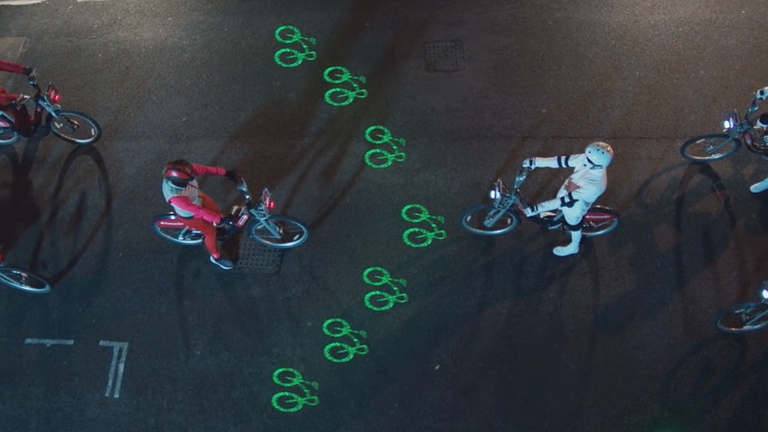
Milan has announced one of Europe’s most ambitious mobility schemes, known as Strade Aperte (open roads). Its goal is to reduce cars in phase 2 of the lockdown by increasing bike lanes and pedestrian areas.
Thousands of hire bikes in London will be fitted with laserlights that project the image of a bike onto the road to improve safety.
London’s hire bikes have become more high-tech and even brighter. Santander Cycles, which manages London’s bike sharing programme in collaboration with Transport for London, decided to use irony to present its new invention: a light installed on the front of vehicles projecting the image of a bike onto the road.
Given the presence of lasers, the initiative has been promoted via a Star Wars-themed video. This features three sportspeople: Jenson Button, winner of the Formula 1 world championship in 2009, golfer Rory McIlroy and Olympic athlete Jessica Ennis-Hill.
After an experimental phase the British city will fit 11,500 hire bikes with a built-in light projecting the image onto the road. Three quarters of those who tested the laserlight on the bikes said they felt safer when using it and half affirmed they would be more willing to use the vehicles at night if fitted with this feature.
“I’m delighted that through this great partnership, we’re able to help improve safety and support the enterprise of another brilliant London start-up,” said cyclist and Mayor of London Boris Johnson, who welcomed the innovation in the city’s bike sharing system.
The laser was produced by Blaze, a start-up company led by founder and design expert Emily Brooke, and promoted through a crowdfunding campaign launched on Kickstarter. Thanks to this, the company collected 55,000 pounds. A single Blazer laserlight costs 125 pounds.
[vimeo url=”https://vimeo.com/108779609″]
Users can be given the codes to use the bikes via the London bike sharing programme app (available on Google Play as well as iTunes). They can also check what docking station have bikes available, consult maps, receive notifications about costs and other information and view their service use history.
Siamo anche su WhatsApp. Segui il canale ufficiale LifeGate per restare aggiornata, aggiornato sulle ultime notizie e sulle nostre attività.
![]()
Quest'opera è distribuita con Licenza Creative Commons Attribuzione - Non commerciale - Non opere derivate 4.0 Internazionale.
Milan has announced one of Europe’s most ambitious mobility schemes, known as Strade Aperte (open roads). Its goal is to reduce cars in phase 2 of the lockdown by increasing bike lanes and pedestrian areas.
Formula 1, the world’s most important auto racing championship, has decided to turn the page and aim for carbon neutrality with the support of its teams, drivers and the whole racing circus.
Toyota and LifeGate began telling the story of hybrid mobility back in 2006, now, on the road to the Tokyo 2020 Olympics, they’re still treading the path of sustainable mobility. Here are the main steps of the journey.
Germany’s first solar bicycle lane could be the prototype for the roads of the future. The photovoltaic tiles melt snow and ice, and are capable of absorbing noise.
The Vespa is back in an electric version. Production has just started and the first models can be reserved online starting from October.
The city of Utrecht, in the Netherlands, is home to a bridge for cycling and walking that stretches over roof garden of a Montessori school. This project enhances practicality and will allow families to bring children to school by bike, passing through green areas. Despite their functionality, bridges are often seen as an infrastructure that is
The Lego hair bike helmet is the latest Internet craze. For now it’s just a prototype but production on a large scale will probably start soon.
Just as fires often give way to new growth, after the Dieselgate scandal, which saw Volkswagen cheating on US emission rules, the German car manufacturer radically changed course, beginning to focus on sustainable mobility. The German car company aims to propose thirty zero-emission models and produce at least one million battery electric vehicles by 2025. An ambitious mission
Sustainable, two-wheel mobility is triumphing in Copenhagen. After years of investments, policies, and infrastructural changes, bikes now outnumber cars in the city centre. The website Copenhagenize has released data linked to the number of vehicles entering the city centre, which are monitored by the city’s administration on a daily basis. Last year, 265,700 bikes have entered








